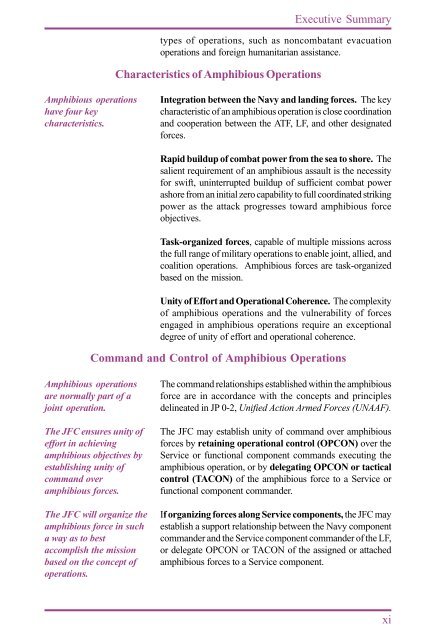Joint Doctrine for Amphibious Operations - Historic Naval Ships ...
Joint Doctrine for Amphibious Operations - Historic Naval Ships ...
Joint Doctrine for Amphibious Operations - Historic Naval Ships ...
- No tags were found...
Create successful ePaper yourself
Turn your PDF publications into a flip-book with our unique Google optimized e-Paper software.
Executive Summarytypes of operations, such as noncombatant evacuationoperations and <strong>for</strong>eign humanitarian assistance.Characteristics of <strong>Amphibious</strong> <strong>Operations</strong><strong>Amphibious</strong> operationshave four keycharacteristics.Integration between the Navy and landing <strong>for</strong>ces. The keycharacteristic of an amphibious operation is close coordinationand cooperation between the ATF, LF, and other designated<strong>for</strong>ces.Rapid buildup of combat power from the sea to shore. Thesalient requirement of an amphibious assault is the necessity<strong>for</strong> swift, uninterrupted buildup of sufficient combat powerashore from an initial zero capability to full coordinated strikingpower as the attack progresses toward amphibious <strong>for</strong>ceobjectives.Task-organized <strong>for</strong>ces, capable of multiple missions acrossthe full range of military operations to enable joint, allied, andcoalition operations. <strong>Amphibious</strong> <strong>for</strong>ces are task-organizedbased on the mission.Unity of Ef<strong>for</strong>t and Operational Coherence. The complexityof amphibious operations and the vulnerability of <strong>for</strong>cesengaged in amphibious operations require an exceptionaldegree of unity of ef<strong>for</strong>t and operational coherence.Command and Control of <strong>Amphibious</strong> <strong>Operations</strong><strong>Amphibious</strong> operationsare normally part of ajoint operation.The JFC ensures unity ofef<strong>for</strong>t in achievingamphibious objectives byestablishing unity ofcommand overamphibious <strong>for</strong>ces.The JFC will organize theamphibious <strong>for</strong>ce in sucha way as to bestaccomplish the missionbased on the concept ofoperations.The command relationships established within the amphibious<strong>for</strong>ce are in accordance with the concepts and principlesdelineated in JP 0-2, Unified Action Armed Forces (UNAAF).The JFC may establish unity of command over amphibious<strong>for</strong>ces by retaining operational control (OPCON) over theService or functional component commands executing theamphibious operation, or by delegating OPCON or tacticalcontrol (TACON) of the amphibious <strong>for</strong>ce to a Service orfunctional component commander.If organizing <strong>for</strong>ces along Service components, the JFC mayestablish a support relationship between the Navy componentcommander and the Service component commander of the LF,or delegate OPCON or TACON of the assigned or attachedamphibious <strong>for</strong>ces to a Service component.xi
















